KH left a note on the Recipes page about Okonomiyaki, a Japanese pancake. Our 17-year old niece Seo Yi, who is visiting from Korea, said, “I know how to make that!” We decided to give it a try.
In Asia, pancakes are eaten as we eat pizza or omelettes – as an all-purpose meal that can have an assortment of ingredients. Feel free to substitute ingredients at will; but this assortment worked very well for us.
Ingredients
The only unusual ingredient you need is yamaimo, the Japanese mountain yam. Yamaimo is also called nagaimo (or two words, yama imo or naga imo); or, can be called Chinese yam or Korean yam or even “slimy potato.” When grated, yamaimo releases a sticky liquid that helps the pancake stick together.
The ingredients may be divided into three groups. The first group makes a batter. We recommend:
- 100 g (2/3 cup) gluten free flour
- 1 tsp baking powder
- 100 ml (1/3 cup) bone broth
- 2 eggs
- Yamaimo (Japanese mountain yam)
The second group provides the vegetables and meats or seafood that make it a meal. We recommend:
- cabbage (2-3 leaves)
- green onion (2-3 stems) or onion (1 medium)
- shrimp (5 large)
- scallops (6 medium)
- shiitake mushrooms (6)
- sweet pickled ginger (optional)
- salt and pepper
Finally an assortment of toppings are added either during cooking or after cooking is done. We recommend:
- bacon (added during cooking)
- sour cream (added after cooking)
Other sauces — okonomiyaki (Chuno) sauce, spicy (Sriracha) sauce – and toppings (eg, dulse or bonito flakes) may be added to your taste. We wouldn’t go out of our way to pick up the Japanese sauces; but we consider the extra fat from the bacon and sour cream to be important, as the brings the macronutrient proportions in line with PHD recommendations and improve the taste.
We made several batches with slightly different sets of ingredients. Here are a few pictures of non-meat ingredients:
Cabbage leaves, eggs, green onion, gluten-free flour, yamaimo section, sweet pickled ginger..
Cabbage leaves, eggs, grated mozzarella cheese (as we mentioned, you can add almost any ingredient), yamaimo, gluten-free flour, baking powder, onion, shiitake mushroom.
And here are the meats we favor – bacon, scallops, and shrimp:
Preparation
Mix the gluten-free flour, baking powder, bone broth, and eggs in a mixing bowl. Peel the Yamaimo and grate it directly over the mixing bowl, releasing its sticky fluid into the batter. Mix well.
Cut the vegetable and meat ingredients into small pieces and mix into the batter. It will start to look like this:
These ingredient amounts will make enough batter for one very large pancake (filling a wok or griddle) or two smaller pancakes.
Warm a wok or griddle at medium heat and add a tablespoon of butter to grease the pan. Pour in the batter and reduce the heat to medium-low.
A large pancake will require ten minutes per side at medium-low heat, smaller pancakes will require about five minutes per side. While the first side is cooking, lay bacon over the top of the pancake and add some batter over the top to help seal the bacon in:
When the first side is sufficiently cooked, flip the pancake and cook the other side. Here is a smaller size pancake – note that it doesn’t fill the pan:
When finished, the large pancake looks like this:
Here is a smaller pancake on a serving plate:
Cut the pancake into slices like a pizza and serve with sour cream:
Or with sour cream and okonomiyaki sauce:
Variations
Any number of meats, toppings, and sauces can be added. Some cooks add potato chips to give the pancake a crunchy texture; we tried this once and it didn’t improve the taste, so we don’t recommend including potato chips.
Here is one variation — so easy a dog can do it! Watch how the Yamaimo releases its sticky fluid when grated:
Conclusion
Okonomiyaki is delicious, is an Asian street standard, and yet most Americans have never tried it. Asians love pancakes, and you’ll know why after trying this!







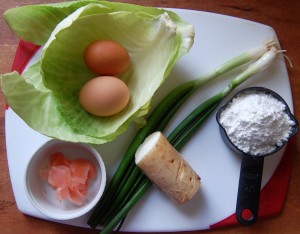
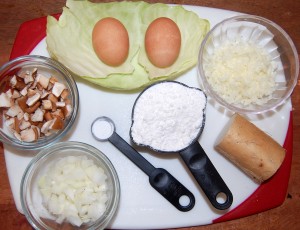
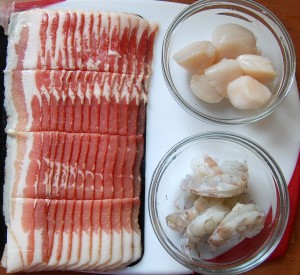
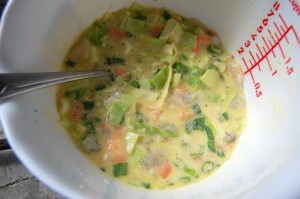
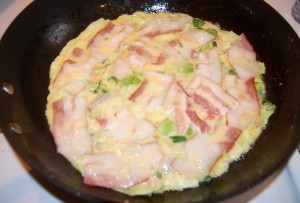
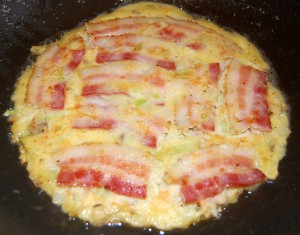
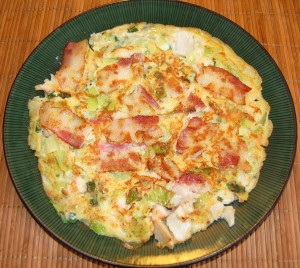
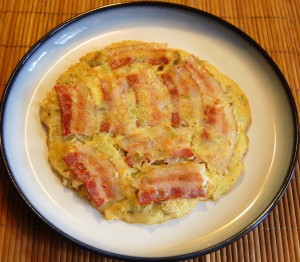
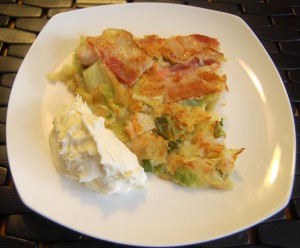
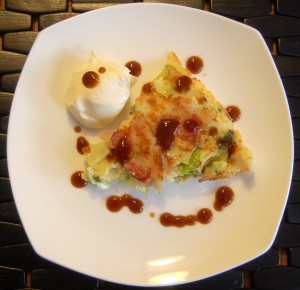




God damn that looks good!
Hi Paul,
Is bacon safe to eat? After reading your series on the dangers of pork I’ve been avoiding bacon and all pork like the plague. What’s your stance on bacon (and pork in general)? Is bacon safe to consume or risky?
Thanks
Hi Bacon,
Our stance is (1) avoid pork blood, liver, and intestines and (2) make sure other pork cuts are well cooked, so that hepatitis E virus will be killed.
So bacon should be reasonably well cooked. We don’t eat it as often as we did before the pork series, but we still have it from time to time.
Should we even avoid pastured pork liver and intestines?
Hi Marisa,
The concern is hepatitis E virus infection so pasturing doesn’t necessarily help.
Be careful when handling nagaimo: some people experience an itchy, painful skin rash within seconds of touching the flesh. When this happened to me while first experimenting with nagaimo I abandoned the idea of eating it. I did not know it was an ingredient in okonomiyaki, one of my favorite Japanese foods—I wonder if it’s safe to eat but not to touch? Or if the irritating agents are neutralized when cooked? Or if the okonomiyaki I occasionally enjoy is actually internally damaging and something I should be avoiding? Bother.
Hi Stephen,
Interesting. I’ve seen it said that it can be eaten raw, but I’ve only had it cooked.
We don’t think it’s essential to the recipe, but it does help the pancake cohere. If I had a skin reaction to it, I wouldn’t eat it either. You might experiment to see if cooked nagaimo affects you the same way.
Oxalates in the skin, I understand; a soak in vinegar is supposed to reduce these. No personal experience yet.
I tried this after KH posted. I didn’t have any mountain yam and didn’t know where to get any so just left it out. It was still yummy. And leftovers were good the next day.
Yes, I don’t think the mountain yam is essential. Just a nice to have for keeping the pancake from crumbling.
I used only tapioca flour because I think becomes more sticky than the other flours. Mine did not crumble.
I suspect that some grated cheese might compensate for absence of the the yam, but my husband has to avoid dairy so I didn’t use it.
Wow that looks amazing!! Gotta find me a Yamaimo!
What about going the traditional way, with a topping of bonito flakes and (homemade) mayonnaise.
Hi Larry,
That’s excellent, as long as the homemade mayonnaise is PHD compatible. We were too lazy to make mayonnaise.
I had made an anchovy dressing recently, a whole jar of anchovies blended into good olive oil, some vinegar, mustard and garlic and lemon juice. It made a good thick sauce that I liked very much on the pancake.
My husband preferred the fermented hot pepper mash we made this year.
Wow, strange…I just made some today from this recipe: http://food52.com/recipes/12352-okonomiyaki
I mixed water with Rice Flour then added the eggs.
Tried one with shrimp, one with bacon. Both very good.
Great to find it here on my favorite blog today.
This was dinner tonight! Yummmmm! I have no idea where to get the yam, so have never used it, and don’t know what I’m missing there. Bacon makes it so good, as does pickled ginger!
Here’s a recipe for a pseudo okonomiyaki sauce
3 Tbl. No HFCS ketsup
3 Tbl. worcestershire sauce
1 Tbl. oyster sauce ( I use fish sauce)
1 TBL. rice syrup
Mix and drizzle on your creation!
Okonomiyaki makes a really easy and quick dinner, when you don’t have energy for much else!
Thanks Dawn!
I used your sauce recipe, Dawn, and it was fantastic and easy – thank you!
Oooh, glad you liked it. I can’t take credit, though. It is a result of an online search. I have NO idea how close it tastes to the real thing, since I haven’t had a chance to have any true Okonomiyaki sauce yet.
Yay for fun Japanese food! Your okonomiyaki looks so good! I think we will try your sour cream idea next time– that sounds better to us than the mayonnaise.
And actually we haven’t even tried it yet with the nagaimo, but I think I will add it next time. I know they have it at the asian store I go to, but I’ve never bought it.
To Dawn- your okonomiyaki sauce recipe sounds good! I can’t remember what exactly I threw in mine, I’m a terrible measurer, I just hand it to my taste-tester husband and stop adding stuff when I get a super YUM! But when I was out of ketchup last time, I used tomato paste, not too much, and that worked well.
To Stephan above– About the nagaimo rash– I don’t know anything about that, but it must be a protective mechanism in the potato. I experienced something similar with a really fresh butternut squash and the skin on my fingers actually peeled right off after I had been chopping it up for 30 min or so, the skin started shriveling and then just a very thin layer peeled right off. I guess I got a free skin peel with my squash purchase! I’m also hoping those things get neutralized/deactivated during cooking!
One of my only gluten exposures while avoiding the many land-mines in Japan recently was when I was handed a hot okonomiyaki by a stand owner in kyoto as a thank-you gift… It felt too cruel not to take a bite and say “delicious!!!” (which it was, very much). I look forward to trying this GF version 🙂
Thank you Paul & Shou-Ching for this recipe! I made it tonight and it was fantastic! For convenience, I altered the ingredients a bit: I used part of a regular sweet potato, rice flour, regular mushrooms and instead of the scallops, shrimp and bacon, I used lamb sausage from my local organic grocery store because that was easier for me and mushroom broth although I could have used the meat juices from cooking the lamb up in the microwave first. I didn’t have baking powder so I made my own substitute using cream of tartar and baking soda. I also used Dawn’s recipe for the sauce – fantastic too! I may have used a bigger piece of sweet potato. My batter made 2 large pancakes and was probably a little too thick because of too much potato. My pan isn’t very good and it did stick, so it wasn’t very pretty, but wow – it really was delicious and very filling!
Wow, that looks delicious! Will be trying this right after the next shopping trip.
Good on you for trying something Japanese even though some of your suggested ingredients diverge enough from the original standard to create something that is not quite okonomiyaki. Your vegetable ingredients are fine. but I would drop the shiitake. In your ingredients you noted “bacon” which would be too salty and should be replaced by plain thin sliced pork which is placed on a flat hotplate first and the batter poured over. Not using okonomi sauce, mayonaise and bonito are probably the main detractions from getting an authentic taste. Sour cream, NO ❗
Nagaimo really does give rashes. Japanese love their slimy foods (think okura for example) and they use the nagaimo starch to make tororo (if I am not mistaken anyway). Tororo is this while, slimy stuff you mix in salads or with noodles and it makes your mouth and tounge itch, and can give rashes too. But it tastes so interesting that I can’t help but eat it!
I discovered this when in the countryside of Japan with my boyfriend (Japanese) who decided to warn me /after/ I had started eating it. And sure enough, I was very very itchy and my lips were tingling!
I am making your recipe for okonomiaki and searched for yamaima at my Korean grocery store. The only thing that looked close was “yellow yam” and no one in the store knew what yamaima was. I bought the yellow yam, cut off the skin and I am soaking it in water and vinegar. I am worried about using it raw because of the toxicity of some uncooked yams, in case this one is NOT yamaima. I think I’ll grate it and cook it in coconut oil before adding it to the flour/batter mix just in case. Hope it will still be a good consistency.
Hi Peggy,
No need to pre cook it as it will cook in the pancake
Cousin El
So, this may sound crazy, but I’ve been using raw pastured pork liver as my liver source for several years. I obviously don’t have Hep E (I suppose I’d know if I did? Or maybe not?). I use it because it comes free every time I buy a whole pig for my family. Is this insane to continue?
I love traditional Asian food, including the pork intestines they use. I haven’t been able to get intestines from my farmer because of USDA regulations, though. Is it so very dangerous when it’s also so very traditional, in both Asian and Southern American cuisines?
Hi JHS, I wouldn’t recommend eating uncooked pork liver. See http://perfecthealthdiet.com/2012/02/the-trouble-with-pork-part-3-pathogens/.
Best, Paul